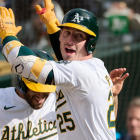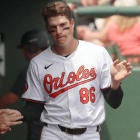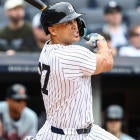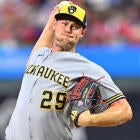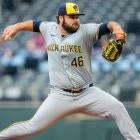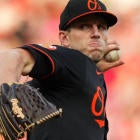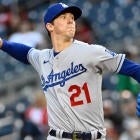Welcome to our 2019 Player Profiles series. We are going through the top-300 in Heath Cummings and Scott White's consensus rankings to give you the case for and the case against drafting each player. By the time you're done, you'll know everything you need to know for drafting in 2019.
Player Rankings: 1-10 | 11-20 | 21-30 | 31-40 | 41-50 | 51-60 | 61-70 | 71-80 | 81-90 | 91-100 | 101-110 | 111-120 | 121-130 | 131-140 | 141-150 | 151-160 | 161-170 | 171-180 | 181-190 | 191-200 | 201-210 | 211-220 | 221-230 | 231-240 | 241-250 | 251-260 | 261-270 | 271-280 | 281-290 | 291-300
21. Corey Kluber, SP, Indians
The Case For: Kluber is the Goldschmidt of pitchers. He's a bit older than you might think given how long he's been around, but he's held up remarkably well. He's been the second-best pitcher in Fantasy over the past three years, and he's struck out at least 220 batters in five straight seasons. He's been durable and excellent. What more could you ask for from a position where "durable" and "excellent" only apply to about as many pitchers as you can count on one hand.
The Case Against: We started to see real signs of decline in 2019. He sported some of the worst peripherals of his career, and averaged his lowest innings-per-start since 2013, before his breakout. His 2018 actually looked a lot like his 2016, with his incredible 2017 season looking like the outlier for recent seasons. Of course, even a diminished Kluber was still a hugely valuable Fantasy option, racking up 222 strikeouts and an ERA below 3.00 -- with the 11th-best FIP in baseball -- but he'll be 33 a few weeks after Opening Day, and if he slides any more, we could see him fall out of the elite tier of pitchers.
22. Andrew Benintendi, OF, Red Sox
The Case For: If you want safety in your second-round pick, Benintendi offers it for sure. He didn't hit for quite as much power in 2018, but he made up for it with a .290 average, while racking up 190 combined runs and RBI. He may not have 2018 Christian Yelich upside, but he's a five-category contributor in a great lineup.
The Case Against: Benintendi really doesn't hit the ball very hard at all. That's not a great thing, given the park he plays in, which is tough for left-handed power. He sports a 31.2 percent hard-hit rate, and fell to 28.0 percent in 2018. He hits the ball in the air plenty, but unless he gets a little stronger and starts making more damaging contact, it's hard to see where he takes a big step forward. Safe, yes; But Benintendi isn't likely to win your league for you.
23. Charlie Blackmon, OF, Rockies
The Case For: What more do I need to say than this: "He was the No. 1 player in Fantasy 2 seasons ago." A bad season for Charlie Blackmon is one in which he hits .291 with 29 homers, 119 runs scored, 70 RBI and 12 steals? I'll take it, thank you very much. He's not leaving Coors Field anytime soon, even if you think his skill set has slipped some, and that alone means he probably needs to go no later than the second round.
The Case Against: The skill set did slip in 2018, of course, and at 32 on Opening Day, there's no guarantee it doesn't get worse. Blackmon's stolen base attempts dropped from 26 and 24 the previous two years to 16 last season, and it's hard to expect that to move in the opposite direction. Yes, Coors Field will prop him up, but it won't make Blackmon immune from the ravages of time, including heightened injury risk. Even Coors won't hide if Blackmon falls off a cliff, and he's at the age where you have to start factoring in that risk.
24. Trevor Story, SS, Rockies
The Case For: Story was arguably the most improved player in baseball. He transformed from a one-dimensional power hitter who struck out as much as anyone north of Arlington, into an all-around threat. Whether you start with the 27 steals -- previous career-high was 23, including the minors -- or the strikeout rate, which dropped into manageable territory at 25.6 percent, Story was a different guy in 2018. He played like a first-rounder, so snagging him in the late second could be the steal of the early rounds.
The Case Against: Or he could turn back into late-period Todd Frazier. Story was a mess in 2018, striking out 34.4 percent of the time, with a .239 average. He was a cheap source of homers and RBI, but that was about it. When players take a big step forward like that, you should naturally be skeptical about regression. That's why Story's available in the late-second instead of the first round.
25. Blake Snell, SP, Rays
The Case For: Everyone's favorite sleeper heading into 2018 still managed to exceed everyone's most optimistic expectations, firing a 1.89 ERA with a 0.98 WHIP and 221 strikeouts. The exception to Tampa Bay's opener experiment, Snell was dominant, refining his control and doubling his curveball usage, to great effect. He backed up his lofty 11.01 K/9 with an elite 15.1 percent swinging strike rate, and induced more swings than ever on pitches out of the strike zone. For a guy who routinely racked up ERAs in the sub-2.00 range in the minors, this was the culmination.
The Case Against: Of course, he wasn't this good. His 2.95 FIP was still very good, but it still shows that he was more run-of-the-mill good, rather than Prime-Sandy-Koufax good. And it's still just one season. It was a very good season, but he still relied heavily on pitching outside of the strike zone. That works when they're swinging at it, but if hitters adjust, we still don't know how or if Snell will adjust to the adjustments. The talent level is massive, but Snell is still inefficient (less than six innings per start), and regression is a major risk.
26. Giancarlo Stanton, OF, Yankees
The Case For: Can I just leave it at: "Was the No. 2 player in Fantasy two years ago?" No, I have to keep writing? OK. Stanton is one of maybe two or three players with legitimate 50-homer upside. We've seen him improve his contact rate, and it's not unreasonable to expect some improvement after his first season in a new park and league.
The Case Against: As with Aaron Judge, this is a volatile skill set. Stanton couldn't sustain the contact gains he made from 2017, and if he slips any more, you start to get into pretty scary territory. The power should give him a high floor regardless, but … well, we thought the same thing about Chris Davis for a while.
27. Juan Soto, OF, Nationals
The Case For: Major League Baseball has existed since 1876. In the 142 years since then, 97 players have seen at least 100 plate appearances as a 19-year-old, and none have ever been better than Juan Soto was last year. Soto's remarkable rookie season ultimately wasn't enough to beat out Ronald Acuña for Rookie of the Year, but he was remarkable in his own right, hitting .292/.406/.517 with 22 homers, 70 RBI, 77 runs, and even five steals. He walked a ton and struck out just 20.0 percent of the time, showing a preternatural ability at the plate. If you're looking for upside, Soto could be historically good. Like, prime Albert Pujols or Joey Votto. He put himself in rarified air in 2018.
The Case Against: Because of injuries, Soto had never played more than 51 games in a season since turning pro in 2016. He's hit everywhere he has gone, but last year was a whole new level. Soto probably won't run much, which means he really has to hit to be a superstar. He may have gotten there last season, but Soto had the 10th-highest ground-ball rate in baseball in 2018, so he may have a pretty low home run ceiling. There's a chance Soto is just the good version of Eric Hosmer — a good hitter, sure, but a reach here.
28. Javier Baez, SS, Cubs
The Case For: Basically Trevor Story, but in Chicago. In fairness, some people have been waiting for this from Baez for a while, but it still represented a massive improvement on his career prior to this. Baez didn't strike out quite as much as Story, but his biggest flaw for years has been plate discipline. I still wouldn't use "discipline" to describe Baez's approach at the plate, but he did swing at more pitches in the zone, and he's always been able to do damage when he gets the fat part of the bat on the ball. A five-tool, high-pedigree prospect finally turned it all that potential into reality.
The Case Against: Or, it was just an outlier year. Baez remains one of the most aggressive hitters in the game, and pitchers already knew not to throw him pitches in the zone if they could avoid it. He hasn't really shown the ability to lay off those pitches, so we're talking about a razor-thin margin for error. If that strikeout rate goes back up, Baez can still be a useful Fantasy option —25 homers and 15 steals will play no matter what — but you're probably going to regret taking him this early.
29. Aaron Nola, SP, Phillies
The Case For: I had my doubts about Nola's skill set in 2016, and then he added 2 mph to his fastball and made me look foolish. Nola excels with both command and control, which allows him to avoid solid contact, and he's developed into an above-average swing-and-miss pitcher to boot. He doesn't just get by on guile and deception anymore. With three straight seasons around the top-10 in FIP, there's no question about it; Nola is a legit ace.
The Case Against: As with Cole, I don't have much concern about performance, but there's still plenty that could go wrong. He suffered a UCL strain in 2016 that limited him 111 innings, and then came back throwing harder than ever. He also had a back injury in 2017 that cost him a few starts, making 2018 the only time in his career he was able to top 180 innings in a season. Coming off throwing 40 innings more than he's ever managed before, Nola certainly carries some risk. Which means Nola has the same risk as basically every pitcher in baseball.
30. Anthony Rizzo, 1B, Cubs
The Case For: If you look at the final numbers, it's hard not to feel like 2018 was a down year for Rizzo. His .283 average was an improvement from the previous season, but he was down in pretty much every other category, including his lowest homer total since 2013 (25). That's all well and good, but you're not paying for past production, you're paying for skill set, and that showed no signs of deteriorating for Rizzo. He posted nearly an identical hard-hit rate in 2018 as 2017, and he actually hit fewer balls on the ground, largely due to a 24.7 percent line-drive rate. In the ways that really matter for projecting 2019, Rizzo looked like the same guy as always. Only now, you can probably get him at a discount.
The Case Against: This is a tough one; I made a pretty compelling argument up there! If you have to make a case against Rizzo, it's probably that he just hasn't shown the upside of some other players being taken behind him. He's never had more than 32 homers, 99 runs, or 109 RBI; he's never hit .300; he's stolen more than 10 bases just once. You're paying for safety here, and that has value, too. But at some point, you have to swing for the fences. Rizzo isn't that pick.
More Player Rankings: 1-10 | 11-20 | 21-30 | 31-40 | 41-50 | 51-60 | 61-70 | 71-80 | 81-90 | 91-100 | 101-110 | 111-120 | 121-130 | 131-140 | 141-150 | 151-160 | 161-170 | 171-180 | 181-190 | 191-200 | 201-210 | 211-220 | 221-230 | 231-240 | 241-250 | 251-260 | 261-270 | 271-280 | 281-290 | 291-300














